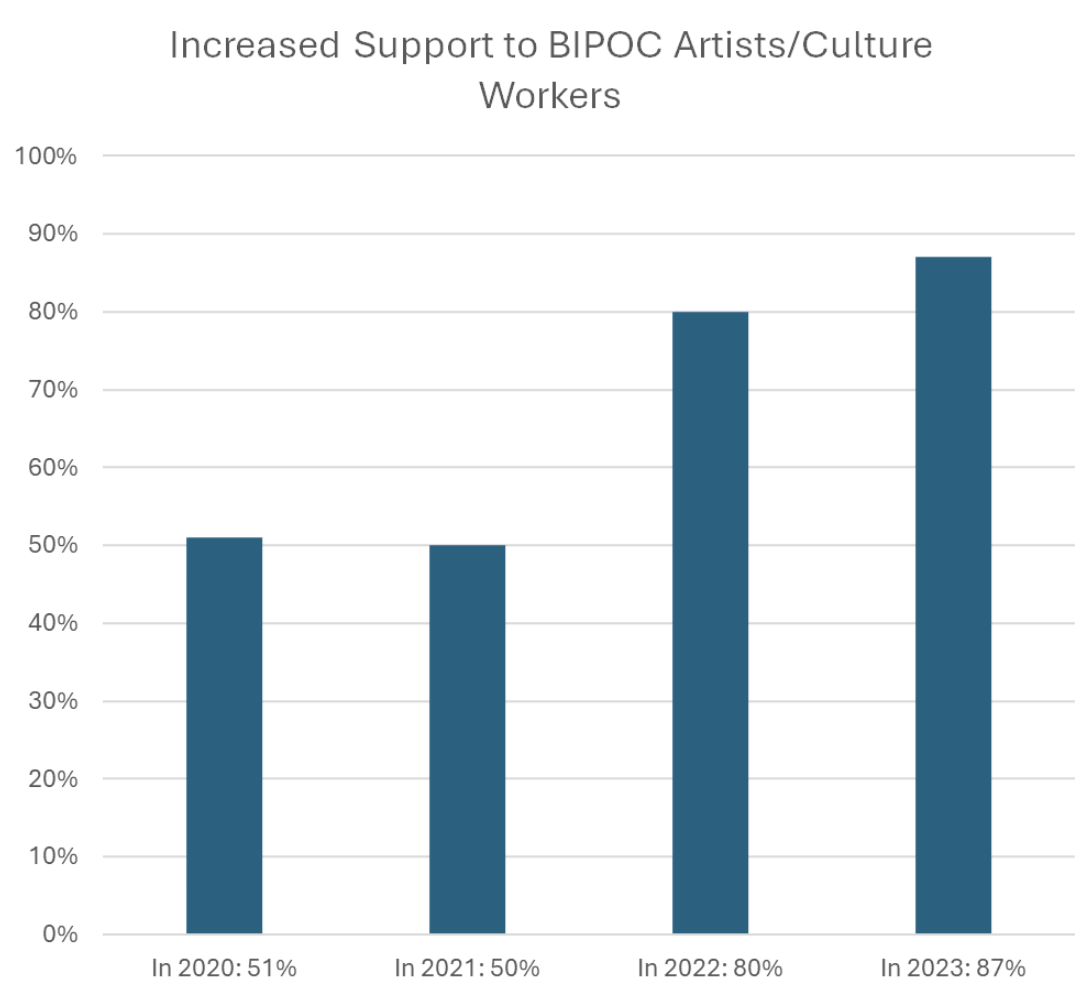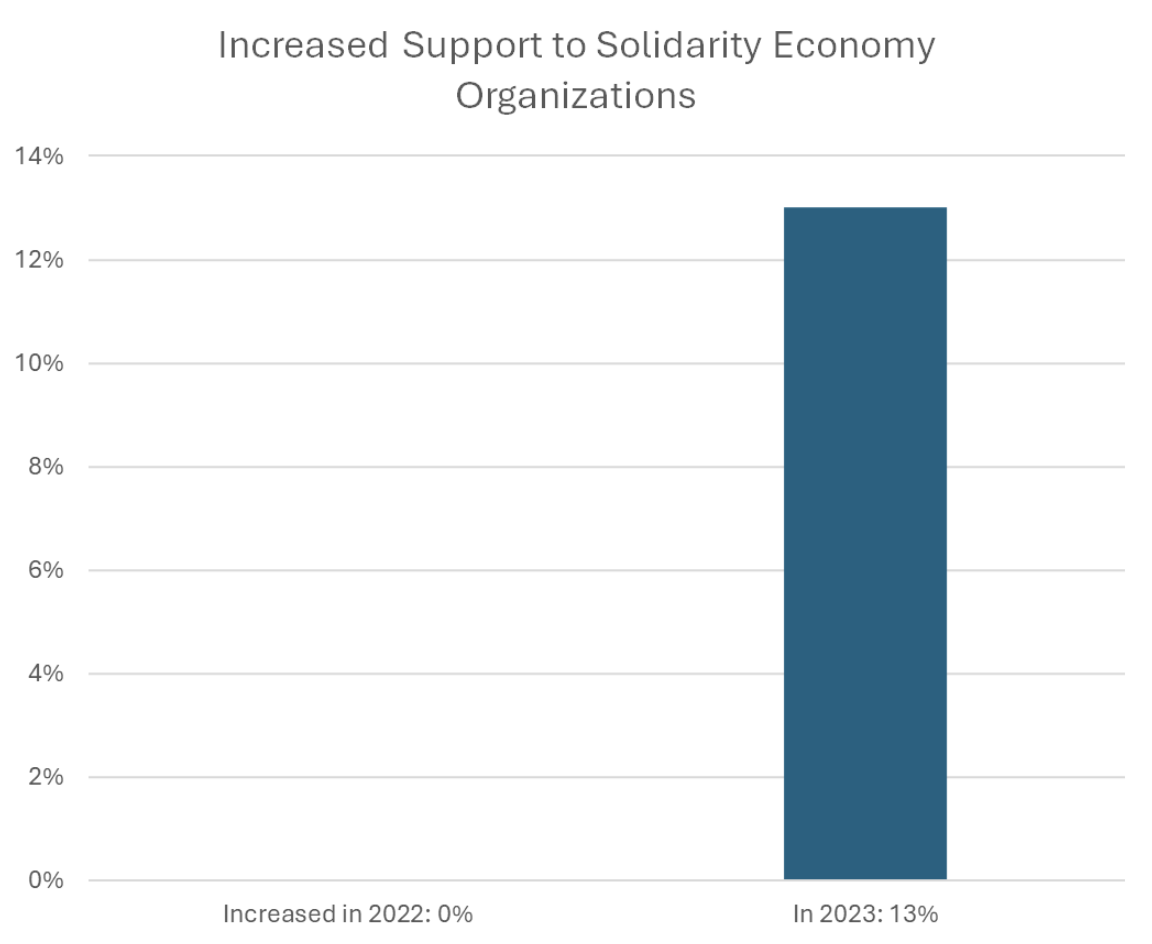Grantmakers’ Changes in Practice 2023
Eddie Torres
Since 2020, Grantmakers in the Arts (GIA) has been sharing the results from a survey of our members’ changes to their grantmaking practices in light of the pandemic and the fight for racial justice. The response rate for the 2023 survey was about 28% of our members and the response rate for each survey question ranged from 15-24% of our members.
As we share in our Capitalization & Nonprofit Financial Health workshops, the cultural community has been sustained through the national grantmaking field’s recent replacement of “pretty bad best practices” with increased general operating support, multi-year support, flexibility, reduced reporting requirements and more equitable funding. It is essential to our nation’s cultural communities that we continue these innovations.
Slowed Giving
Over the prior 3 years, 50-57% of our members responded that they’d increased their support for the arts and culture field. The slowing of these increases is revealed by our survey respondents’ revelation that only 36% have increased their support in 2023; with the majority (58%) keeping their support flat. This is in line with field-wide trends, which showed more foundations anticipating decreases in giving in 2023 than anticipated increases.
Slowed General Operating Support
Increases in general operating support are slowing after having increased by 56% of survey respondents in 2020, 65% in 2021, and 55% in 2022. Only 51% of GIA’s survey respondents increased their general operating support in 2023. As we explain in our Capitalization & Nonprofit Financial Health workshops, general operating support is one of the main ways that nonprofit organizations acquire and grow sufficient capital funds to weather rainy days, take risks, and change for the sake of better supporting artists and arts participants over the long term.
Decreased Flexibility
Increased flexibility in the use of funds slowed after having increased by 80% in 2020, and 89% in 2021. In 2023, only 45% of GIA’s survey respondents said they’ve increased flexibility in grantees’ use of their funds.
Reporting Requirements
Reporting requirements are tightening after having been loosened for years. In 2020, 69% of GIA’s survey respondents relaxed their reporting requirements with 75% doing so in 2021, 45% in 2022, but only 43% in 2023.
At a recent workshop, GIA’s capitalization consultant had an exchange with a funder in which the funder asserted, “Writing proposals and reports is the job of arts organizations.” Rebecca Thomas responded, “No, it’s not. That’s your job. Arts organizations are responsible for creating and sharing art.” It is essential that we keep arts organizations in the business of supporting artists and audiences rather than filling in paperwork for short-term funding.
Changes in Multi-Year Support
There is good news: 45% of GIA’s survey respondents increased their multi-year support in 2023, the highest percentage yet.
Funding Individual Artists
One of GIA’s priorities is grantmakers’ Support for Individual Artists, because artists are essential workers without whom our humanity would be gravely affected. Increases in funders’ support for artists appear to be slowing – going from 41% in 2020 to 45% in 2022. We’re back to 41% in 2023.
Expanding Support to Include Artists
There are bright spots in our field’s support for artists. More grantmakers are expanding their funding to include support for individual artists. Expansion into artist support is remaining steady at 26% of survey respondents in 2023, the same percentage as 2020 and higher than in 2022.
Support for Racial Equity in Arts Funding
GIA’s central priority is Racial Equity in Arts Funding. GIA articulates support for cultural self-determination as part of economic self-determination – not a nice-to-have, but essential to survival. The percentage of GIA’s survey respondents that have increased their support to BIPOC artists is at 87%, our highest rate yet. The percentage of GIA’s survey respondents that have increased their support to BIPOC organizations is tied for 2022 for the highest percentage yet – 73%.







Support for Artists with Disabilities
In our support of equity, GIA is race-explicit but not race-exclusive. GIA advocates for cultural and economic self-determination for people with disabilities, especially in light of the intersecting forms of oppression for racialized people with disabilities. The percentage of GIA’s survey respondents that have increased their support to artists with disabilities is tied with 2022 at 40%.
Support for Solidarity Economy and the Arts
GIA shares information about the solidarity economy as part of our advocacy for cultural and economic self-determination, including endorsing the National Worker Cooperative Development and Support Act. Support to artists working as part of solidarity economies has risen from 7% of GIA’s survey respondents in 2022 to 13% in 2023 – almost twice as many. Support to organizations working as part of solidarity economies has gone from 0 survey respondents in 2022 to 13% in 2023.
Support for Trans Artists
However, increases in support to Trans artists has fluctuated from 20% of survey respondents in 2021 to 53% in 2022 to 7% in 2023. As Funders for LGBTQ issues articulates, “the far-right has escalated its brutal attacks against racial, queer, and reproductive rights and justice. Attacks on Black trans and gender-expansive artists, writers, and cultural organizers have ranged from criminalizing drag queens to book bans. While these attacks continue to expand nationwide, there is a deep need for expanded philanthropic investment and support for Black TGNC artists and cultural organizers.” Bré Rivera, founder of Black Trans Fund, highlights in a GIA conference plenary, that we must support Black TGNC artists’ expressions of joy as part of supporting their full brilliance.
We must use this moment to highlight the communities that need our support the most. Indiana University, the Lilly Family School of Philanthropy , and the CCS Fundraising project that philanthropic giving will increase in 2024 and 2025. We must ensure that these increases will work in favor of the work that organizations and individual artists have been working towards uplifting.
In Conclusion
We must celebrate our field’s successes: the increases in multi-year support, the expansion into artist support, the increased support for BIPOC organizations and artists, and artists with disabilities and solidarity economies. When asked what GIA provides that has positively influenced our members’ changes to their grantmaking practices, attendees overwhelmingly replied that with “access to one another’s experiences, insights, and support.” GIA’s members can also support each others' embrace of general operating support, flexibility, reduced reporting requirements as well as the inclusion of Trans artists specifically and intersectionality across the board. Our nation relies upon our courage and commitment.
ABOUT THE AUTHOR
Eddie Torres is president & CEO of Grantmakers in the Arts






